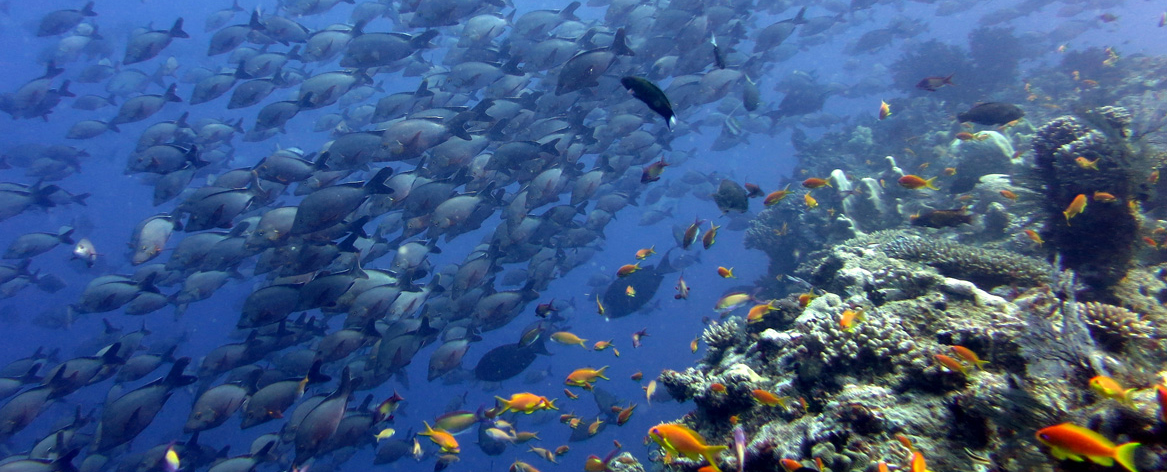Risk Factors
We know from several recent studies that Vamizi’s reefs are among the healthiest in Africa having been relatively unaffected by recent coral bleaching events. However, several factors exist which could threaten the health of Vamizi’s surrounding reefs:
GLOBAL CLIMATE CHANGES
Climate change is one of the biggest threats faced by coral reefs and many other marine species. One third of reefs worldwide have been killed by severe climate factors that lead to strong bleaching events. Because tropical waters are poor in nutrients, corals rely on a symbiotic relationship with microalgae in order to obtain the quantity of nutrients they require to survive. These microalgae are what give corals their beautiful colours, which we still experience in Vamizi.
If water temperatures increase above a certain threshold, the microalgae are no longer capable of producing nutrients through photosynthesis, and end up being expelled by the coral, which loses its colour (hence the term bleaching). If the temperature remains high for long periods, corals will end up starving to death, unable to find enough nutrients to survive.
The death of corals will then affect many other species which depend on them for survival, be it as a food source or a home.
Other species will also be affected by climate change. As just one example, sex determination in sea turtles is temperature dependent, with higher temperatures producing more females. Temperature also affects nesting seasonality, and there is already evidence of nesting populations shifting their nesting seasons to compensate for higher temperatures, and “feminization” of certain populations, which will have a severe impact on their survival.
POPULATION PRESSURES AND OVER FISHING
With the rapid increase of fish stocks brought about by the community sanctuary/no-fishing zone, Vamizi is at risk of becoming a mecca for itinerant fishermen. These fishermen, from other Mozambican provinces, and even as far afield as Tanzania, arrive with more efficient and destructive equipment, and a less responsible attitude – they have no connection or responsibility to the island and its seas. Juvenile fish which are not of reproductive age or size are caught, as well as endangered species and reef fish, and scant regard is shown to the authority of the Vamizi CCP (Community Council for Fisheries). This adds a greater pressure to the rich reefs encircling Vamizi, and a social and economic threat to the local fishermen on the island.
An expanding population in the region caused by increased economic activity in the north of Mozambique also adds pressure to fish stocks as more families need to be fed, and fish provides an attractive source of protein.
OFFSHORE NATURAL GAS EXPLORATION IN THE REGION
Gas exploration is a threat to certain key species, in particular marine mammals and coral reefs. The oil and gas industry poses three distinct threats to migrating whales: habitat loss, pollution and possible hearing damage. During seismic surveys used in the exploration for oil and gas, both high and low frequency sounds are directed through the seabed to establish the boundaries defining different geological layers. The sounds at low frequencies overlap with those used by baleen whales, and higher frequency sounds overlap with those used by toothed whales and dolphins. Pollutants and toxic substances from activities relating to the oil industry are also a health risk to several marine species.
Increased boat traffic around an offshore exploration or drilling site is an activity with many documented cases of impact on marine mammals and their habitats. It can cause marine mammals to temporarily abandon or avoid a particular area, and in the long term, it may create a permanent abandonment of areas visited by these animals. Boat traffic can also lead to interruption of natural behaviour as it may turn the animal’s attention away from essential activities like foraging, feeding, socializing and breeding. The presence of big vessels, such as the ones used in the oil and gas industry, increase the risk of strikes or collisions with marine mammals, which can lead to death or severe injury to whales and dolphins.
The offshore gas industry may also have a negative impact on the coral reefs themselves. Intensive boat traffic around the time of coral spawning events could affect the dispersal of surface spawn slicks, hindering the supply of larvae and hence the reproductive process of certain reefs. The construction of an underwater gas pipeline usually requires the physical removal of corals from the reef structure, which can reduce the breeding population and diminish the source of larval supply. In addition, operations such as dredging lead to an increase in suspended particles in the water, which has a negative effect on coral reproduction.

